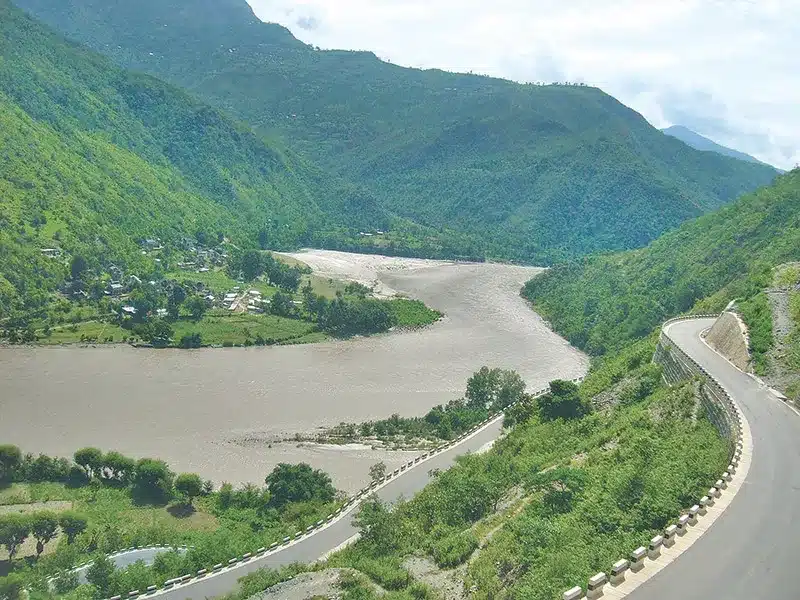About Sunkoshi River:
- Sunkoshi, also known as the ‘river of gold, is a river in Nepal that is part of the Koshi or Saptkoshi River system formed by the seven (sapta) rivers joining in east-central Nepal.
- Course: River Sunkoshi’s water source is located in the Zhangzangbo Glacier in Tibet, which merges with River Saptkoshi, ultimately joining the Gangain the Katihar district of Bihar in India, before finally draining into the ocean at the Bay of Bengal in Bangladesh.
- It is one of the longest and most popular rivers for rafting in Nepal, and is known for its challenging rapids.
- It forms the watershed for most of eastern Nepal.
Key Facts about Koshi River:
- It is a transboundary river which flows through China, Nepal, and India.
- It is a prominent tributary of the Ganges.
- Course: Originating from the Tibetan Plateau, it crosses the Himalayas and flows through the Mahabharat range and Siwalik hills, reaching the plains of eastern Nepal and finally meeting the Ganges in Bihar, India.
- The Kosi drains an area of 74,500 sq.km, of which only 11,070 sq.km lie within Indian Territory. The Koshi River system drains about 45% of Nepal.
- The Kosi River valley is bounded by steep margins that disconnect it from the Yarlung Zangbo River to the north, the Mahananda River to the east, the Gandaki to the west, and the Ganga to the south.
- It is well known for its tendency to change course, generally in a westward direction. During the last 200 years, the river has shifted westwards for a distance of about 112 km and has laid waste large tracks of agricultural land
- Kosi is known as the “sorrow of Bihar”, as it has caused widespread human suffering in the past due to flooding and very frequent changes in course, when it flows from Nepal to Bihar.
- Tributaries: It has seven major tributaries: Sun Koshi, Tama Koshi or Tamba Koshi, Dudh Koshi, Indravati, Likhu, Arun, and Tamore or Tamar.
Q1: Which are the main tributaries of Ganges River?
The Yamuna, the Ghaghara, the Gandak and the Kosi are the major tributaries of the river Ganga.
Source: River Sunkoshi Cleanup In Nepal Removes 24,575 Kg Of Plastic In 36 Hours
Last updated on November, 2025
→ Check out the latest UPSC Syllabus 2026 here.
→ Join Vajiram & Ravi’s Interview Guidance Programme for expert help to crack your final UPSC stage.
→ UPSC Mains Result 2025 is now out.
→ UPSC Notification 2026 is scheduled to be released on January 14, 2026.
→ UPSC Calendar 2026 is released on 15th May, 2025.
→ The UPSC Vacancy 2025 were released 1129, out of which 979 were for UPSC CSE and remaining 150 are for UPSC IFoS.
→ UPSC Prelims 2026 will be conducted on 24th May, 2026 & UPSC Mains 2026 will be conducted on 21st August 2026.
→ The UPSC Selection Process is of 3 stages-Prelims, Mains and Interview.
→ UPSC Result 2024 is released with latest UPSC Marksheet 2024. Check Now!
→ UPSC Prelims Result 2025 is out now for the CSE held on 25 May 2025.
→ UPSC Toppers List 2024 is released now. Shakti Dubey is UPSC AIR 1 2024 Topper.
→ UPSC Prelims Question Paper 2025 and Unofficial Prelims Answer Key 2025 are available now.
→ UPSC Mains Question Paper 2025 is out for Essay, GS 1, 2, 3 & GS 4.
→ UPSC Mains Indian Language Question Paper 2025 is now out.
→ UPSC Mains Optional Question Paper 2025 is now out.
→ Also check Best IAS Coaching in Delhi

















